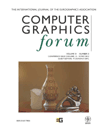
COMPUTER GRAPHICS FORUM
Scope & Guideline
Advancing the Art of Visualization
Introduction
Aims and Scopes
- Real-Time Rendering Techniques:
Research in this area explores methods to achieve high-quality graphics output while maintaining performance for interactive applications, including video games and simulations. - 3D Modeling and Animation:
This scope includes the development of techniques for creating and animating 3D objects, focusing on both procedural generation and manual modeling techniques. - Visualization and Visual Analytics:
Papers often delve into methods for effectively visualizing complex data sets, including the use of interactive techniques to aid in data exploration and understanding. - Machine Learning Applications:
The journal features research on applying machine learning techniques to enhance graphics processes, such as neural rendering and generative models. - Simulation and Physical Modeling:
This involves the use of physics-based approaches for simulating realistic behaviors in graphics, such as fluid dynamics, cloth simulation, and rigid body dynamics. - User-Centric Design and Evaluation:
Research focused on understanding user interactions with graphics systems, including accessibility and usability studies.
Trending and Emerging
- Neural Rendering and Generative Models:
There is a growing trend in the application of neural networks for rendering tasks, including generative adversarial networks (GANs) for texture synthesis and image generation. - Real-Time Ray Tracing:
Research in real-time ray tracing has surged, focusing on techniques that allow for high-fidelity lighting and shadow effects in interactive applications, driven by advancements in hardware. - Virtual and Augmented Reality Technologies:
The rise of VR and AR has led to increased research on rendering techniques and user interaction methods that enhance immersive experiences. - Data-Driven Graphics Techniques:
Utilizing large datasets and machine learning to inform graphics processes, such as scene reconstruction and object recognition, is becoming increasingly prominent. - Interactive Visualization and User Experience:
A significant focus on enhancing user interaction with visual data through innovative visualization techniques that prioritize user experience and accessibility.
Declining or Waning
- Traditional Rasterization Techniques:
While still relevant, traditional rasterization methods are increasingly overshadowed by advancements in real-time ray tracing and hybrid rendering techniques, leading to fewer publications in this area. - Static Mesh Optimization:
The focus on optimizing static meshes has diminished as the industry moves towards dynamic and procedural generation methodologies that allow for more flexible and efficient rendering. - Legacy Graphics APIs:
Research centered around older graphics APIs is declining as newer, more efficient APIs (such as Vulkan and DirectX 12) gain traction and become the standard for graphics programming. - Basic Texture Mapping Techniques:
As the complexity of graphics increases, simpler texture mapping techniques are being replaced by more advanced methods such as texture synthesis and procedural texturing. - 2D Graphics Techniques:
Interest in traditional 2D graphics techniques is waning as the focus shifts towards 3D graphics, immersive environments, and applications in virtual and augmented reality.
Similar Journals
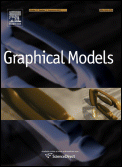
GRAPHICAL MODELS
Innovating Visual Solutions for Tomorrow's ChallengesGRAPHICAL MODELS, published by Academic Press Inc Elsevier Science, is a cutting-edge journal in the fields of Computer Graphics and Computer-Aided Design, Geometry and Topology, Modeling and Simulation, and Software. Since becoming Open Access in 2023, it has expanded its reach, facilitating scholarly communication and encouraging a diverse range of submissions. Operating from the heart of San Diego, United States, the journal has established itself with an impressive ranking, including a Q2 category in multiple disciplines and a notable position in Scopus, particularly in Geometry and Topology, where it ranks #8 out of 106. This journal aims to provide a comprehensive platform for innovative research and application-focused studies, attracting the attention of researchers, professionals, and students who are keen to explore the dynamic landscape of graphical models and their implications across various scientific and engineering domains. With its commitment to publishing high-quality research, GRAPHICAL MODELS is a pivotal resource for anyone interested in advancing the frontiers of graphical representations and simulations.

Acta Cybernetica
Illuminating Trends in Theoretical Computer Science.Acta Cybernetica, published by the University of Szeged, Faculty of Science, serves as a vital platform for researchers and practitioners in the fields of computational theory, computer science, and engineering. With an ISSN and E-ISSN of 0324-721X, this Hungarian journal has been disseminating valuable research since 1990 and is projected to continue through 2024. Although it currently holds a Q4 ranking in multiple categories—including computational theory, computer vision, and theoretical computer science—its impact lies in fostering innovative research discussions and multidisciplinary collaborations. Scholars in its specialized fields will find a wealth of insights that contribute to emerging trends and developments. While Acta Cybernetica is not an open-access journal, it remains an essential resource for advancing knowledge and practices within its academic community.
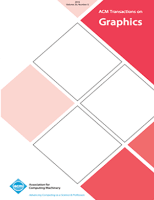
ACM TRANSACTIONS ON GRAPHICS
Illuminating the Future of Graphics TechnologyACM Transactions on Graphics, a premier journal published by the Association for Computing Machinery, stands at the forefront of research in the field of computer graphics and computer-aided design. With its ISSN 0730-0301 and E-ISSN 1557-7368, this highly respected publication has maintained a stellar reputation since its inception in 1982, showcasing groundbreaking work that spans the latest innovations and applications in graphics technology. Ranked within the top tier (Q1) of its category in 2023 and occupying the 5th position out of 106 in the Scopus rankings, this journal holds a significant impact factor, reflecting its critical role in advancing knowledge and fostering collaboration among researchers, professionals, and students alike. Although it does not offer open access options, the journal provides a diverse array of scholarly articles aimed at delineating theoretical advances, practical techniques, and emerging trends within the discipline, ensuring that its readership remains at the cutting edge of the evolving landscape of digital graphics.
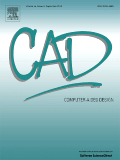
COMPUTER-AIDED DESIGN
Elevating Design Practices with High-Impact ResearchCOMPUTER-AIDED DESIGN is a premier journal published by Elsevier Science Ltd, dedicated to the dynamic fields of Computer Graphics and Computer-Aided Design, as well as Industrial and Manufacturing Engineering. With a long-standing history since its inception in 1968, this journal plays a vital role in disseminating high-quality research and innovative methodologies that shape the future of design and engineering practices. It is positioned in the upper quartiles (Q1 and Q2) across multiple categories, highlighting its impact and reputation, with a notable 74th percentile ranking in Computer Graphics and Computer-Aided Design related fields. Researchers, professionals, and students will find valuable insights and advancements that not only push the boundaries of knowledge but also facilitate practical applications in the industry. The journal's emphasis on enhancing collaboration between academia and industry aligns with contemporary trends towards integrated design and manufacturing processes, making it an essential resource for anyone looking to stay at the forefront of technological advancement. Authors are encouraged to submit original articles that contribute to the multidisciplinary discourse within these domains.
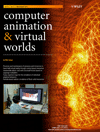
COMPUTER ANIMATION AND VIRTUAL WORLDS
Pioneering Research in Virtual Worlds and Computer Graphics.COMPUTER ANIMATION AND VIRTUAL WORLDS, published by Wiley, is a pivotal journal in the fields of Computer Graphics and Computer-Aided Design, as well as Software. With a focus on the intersection of technology and creativity, the journal provides a platform for researchers and professionals to share innovative studies, new methodologies, and insights that shape the future of computer animation and virtual environments. Currently holding a Q2 category in Computer Graphics and a Q3 in Software for 2023, it ranks #63 out of 106 in its niche, highlighting its influence and relevance in the academic community. Though the journal operates under a subscription model, it also offers options for open access, ensuring that a broader audience can engage with groundbreaking research. The journal has been publishing continuously since its inception in 2004 and looks forward to further contributions as it moves towards its 20th anniversary in 2024. Whether you are a seasoned researcher, an industry professional, or a student eager to explore these dynamic fields, COMPUTER ANIMATION AND VIRTUAL WORLDS is an essential resource for advancing knowledge and innovation.
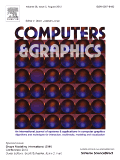
COMPUTERS & GRAPHICS-UK
Pioneering Insights in Human-Computer InteractionCOMPUTERS & GRAPHICS-UK is a premier journal dedicated to the fields of computer graphics, computer-aided design, and human-computer interaction. Published by Pergamon-Elsevier Science Ltd, this esteemed journal has been a critical resource for researchers and professionals since its inception in 1975. With an impressive impact factor and ranked in the second quartile for key disciplines such as Computer Vision and Pattern Recognition, and Engineering (Miscellaneous), it provides a platform for high-quality, peer-reviewed research spanning theoretical advancements, innovative technologies, and practical applications. Notable for its interdisciplinary approach, the journal also embraces contributions that bridge diverse areas within computer science. Although lacking Open Access options, readers can benefit from its rich archive and cross-disciplinary insights, making it essential for anyone looking to advance their knowledge and practice in computer graphics and related fields. The journal is located in the United Kingdom, at The Boulevard, Langford Lane, Kidlington, Oxford OX5 1GB, and continues to be a cornerstone for scholarly exchange and advancement in the digital visualization domain.
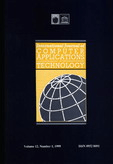
INTERNATIONAL JOURNAL OF COMPUTER APPLICATIONS IN TECHNOLOGY
Pioneering research in technology for industry and academia.International Journal of Computer Applications in Technology is a reputable academic journal published by InderScience Enterprises Ltd, dedicated to advancing the field of computer applications across various domains including Computer Networks and Communications, Computer Science Applications, and more. With an ISSN of 0952-8091 and an E-ISSN of 1741-5047, this journal has been a credible source of research since its inception in 1976, transitioning into its current form in 1988. With its consistent rank in the Q3 quartile for several key engineering and computer science categories in 2023, it highlights the significance of the journal and its contributions to ongoing discourse in these fields. Researchers benefit from its wide-ranging scope, which encompasses both theoretical and practical applications of technology, making it an invaluable resource for both industry professionals and academic scholars. Although it currently does not provide open access, the journal remains committed to disseminating high-quality research that is essential for technological advancement and innovation.

CCF Transactions on Pervasive Computing and Interaction
Advancing the Future of Interactive ComputingCCF Transactions on Pervasive Computing and Interaction, published by SPRINGERNATURE, is a leading academic journal dedicated to advancing the field of pervasive computing and interaction. With an ISSN of 2524-521X and E-ISSN 2524-5228, this journal is well-regarded for its rigorous peer-reviewed research, featuring influential studies that explore the intersection of Artificial Intelligence, Computer Networks and Communications, Computer Science Applications, and Human-Computer Interaction. Recognized in the 2023 journal rankings, it holds a prestigious Q2 quartile classification across these domains, reflecting its impact and relevance in the academic community. Researchers and practitioners can greatly benefit from its contributions, showcasing innovative approaches and technologies that shape the future of interactive computing. Although currently not following an open-access model, the journal underscores its commitment to high-quality research dissemination, making it a vital resource for those interested in the evolving landscape of pervasive technologies and user-centric designs. For more information on submissions and access options, please refer to the official website.
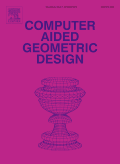
COMPUTER AIDED GEOMETRIC DESIGN
Bridging Disciplines with Geometric PrecisionCOMPUTER AIDED GEOMETRIC DESIGN is a premier journal dedicated to the interdisciplinary field of geometric design, showcasing cutting-edge research that intersects with Aerospace Engineering, Automotive Engineering, and Computer Graphics. Published by ELSEVIER in the Netherlands, this esteemed journal has maintained its relevance and impact since its inception in 1984, with a converged publication strategy continuing through 2024. Currently categorized in Q2 across multiple domains, including Aerospace Engineering and Computer-Aided Design, it reflects a solid standing within the academic community. Researchers can access high-quality articles, contributing to the advancement of applied mathematics and simulation methodologies. Despite not being an open-access journal, it offers significant insights that support innovation in design processes, making it a vital resource for academics, professionals, and students aiming to deepen their understanding and explore new possibilities in geometric design and related fields.

Advances in Computational Design, An International Journal
Advancing Knowledge at the Intersection of Technology and ArtAdvances in Computational Design, an esteemed international journal published by TECHNO-PRESS, focuses on the dynamic intersection of computational mathematics, mechanics, and computer graphics. This journal provides a platform for researchers and practitioners alike to contribute to the rapidly advancing fields of computational design, fostering innovation in methodologies and applications. With a ranking placing it in the Q4 category for Computational Mathematics and in the Q3 categories for both Computational Mechanics and Computer Graphics, it is recognized for its impact within academic and professional circles. Given its launch in 2016, the journal has cultivated a significant community of scholars aiming to push the boundaries of computational techniques. The Scopus rankings demonstrate its visibility and relevance, with notable positions in key categories. Although the journal operates under a traditional subscription model, the rich array of research articles available through its platform continues to enrich scholarly dialogue and advance understanding in the field. For those pursuing cutting-edge developments in computational design and its applications, Advances in Computational Design serves as an invaluable resource.